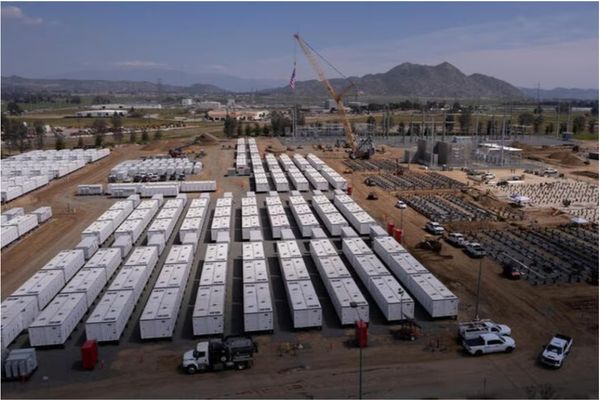Tumble in storage battery costs to boost shift to renewables, says IEA

An expected sharp fall in battery costs for energy storage in coming years will accelerate the shift to renewable energy from fossil fuels, the International Energy Agency (IEA) said on Thursday.
While renewable energy by itself is already much cheaper than coal and gas-fired plants, weather can interrupt solar and wind power and must be paired with energy storage systems to provide reliable sources of energy.
The total capital costs of battery storage are due to tumble by up to 40% by 2030, the Paris-based watchdog said in its Batteries and Secure Energy Transitions report.
"The combination of solar PV (photovoltaic) and batteries is today competitive with new coal plants in India," said IEA Executive Director Fatih Birol.
"And just in the next few years, it will be cheaper than new coal in China and gas-fired power in the United States. Batteries are changing the game before our eyes."
About 90% of lithium ion batteries are used in the transport sector, which focuses on dense and light units. There is more scope for cutting costs in energy storage batteries, which can be larger and heavier.
Cheaper lithium iron phosphate (LFP) batteries accounted for 80% of new storage batteries last year, the IEA said.
Cheaper sodium-ion batteries will account for less than 10% of electric vehicle batteries by 2030, but they will make up a growing share of energy storage batteries, it added.
The global market for energy storage doubled last year to over 90 gigawatt-hours (GWh), the report said.
Overall global energy storage capacity is due to soar six-fold by 2030, with batteries accounting for 90% of the rise and pumped hydropower for most of the rest.
Pumped hydropower is a system that involves pumping water to a higher reservoir during off peak times to generate electricity at peak times.
The slide in battery costs will also help provide electricity to millions of people without access, cutting by nearly half the average electricity costs of mini-grids with solar PV coupled with batteries by 2030, the IEA said.
Vietnamese version:
IEA cho biết chi phí pin lưu trữ giảm sẽ thúc đẩy chuyển đổi sang năng lượng tái tạo
Hôm thứ Năm cơ quan Năng lượng Quốc tế (IEA) cho biết chi phí pin dự trữ để lưu trữ năng lượng sẽ giảm mạnh trong những năm tới sẽ đẩy nhanh quá trình chuyển đổi sang năng lượng tái tạo từ nhiên liệu hóa thạch.
Mặc dù bản thân năng lượng tái tạo đã rẻ hơn nhiều so với các nhà máy đốt than và khí đốt, nhưng thời tiết có thể làm gián đoạn năng lượng mặt trời và năng lượng gió nên phải kết hợp với hệ thống lưu trữ năng lượng để cung cấp nguồn năng lượng ổn định.
Trong báo cáo về Pin và Chuyển đổi Năng lượng An toàn, tổng chi phí vốn cho việc lưu trữ pin sẽ giảm tới 40% vào năm 2030.
Giám đốc điều hành IEA, ông Fatih Birol cho biết: “Sự kết hợp giữa năng lượng mặt trời (quang điện) và pin ngày nay có khả năng cạnh tranh với các nhà máy sử dụng than kiểu mới ở Ấn Độ”.
"Và chỉ trong vài năm tới, nó sẽ rẻ hơn giá điện từ nhà máy sử dụng than kiểu mới ở Trung Quốc và năng lượng chạy bằng khí đốt ở Hoa Kỳ. Pin lưu trữ đang thay đổi cuộc chơi trước mắt chúng ta."
Khoảng 90% pin lithium ion được sử dụng trong lĩnh vực giao thông vận tải, trong đó tập trung vào các loại pin đặc và nhẹ. Có nhiều khoảng trống để cắt giảm chi phí đối với pin lưu trữ năng lượng, loại pin này có thể lớn hơn và nặng hơn.
IEA cho biết pin lithium iron phosphate (LFP) rẻ hơn chiếm 80% số pin lưu trữ mới vào năm ngoái.
Pin natri-ion rẻ hơn chiếm ít hơn 10% pin xe điện vào năm 2030, nhưng chúng sẽ chiếm tỷ trọng ngày càng tăng trong pin lưu trữ năng lượng.
Báo cáo cho biết thị trường lưu trữ năng lượng toàn cầu đã tăng gấp đôi vào năm ngoái lên hơn 90 gigawatt giờ (GWh).
Nhìn chung, khả năng lưu trữ năng lượng toàn cầu sẽ tăng gấp sáu lần vào năm 2030, trong đó pin chiếm 90% mức tăng và thủy điện chiếm phần lớn phần còn lại.
Thủy điện tích năng là một hệ thống bao gồm việc bơm nước lên hồ chứa cao hơn trong thời gian thấp điểm để tạo ra điện vào thời gian cao điểm.
IEA cho biết chi phí pin giảm cũng sẽ giúp cung cấp điện cho hàng triệu người, và cắt giảm gần một nửa chi phí điện trung bình của các lưới điện mini sử dụng năng lượng mặt trời kết hợp với pin vào năm 2030.





 Dịch
Dịch









